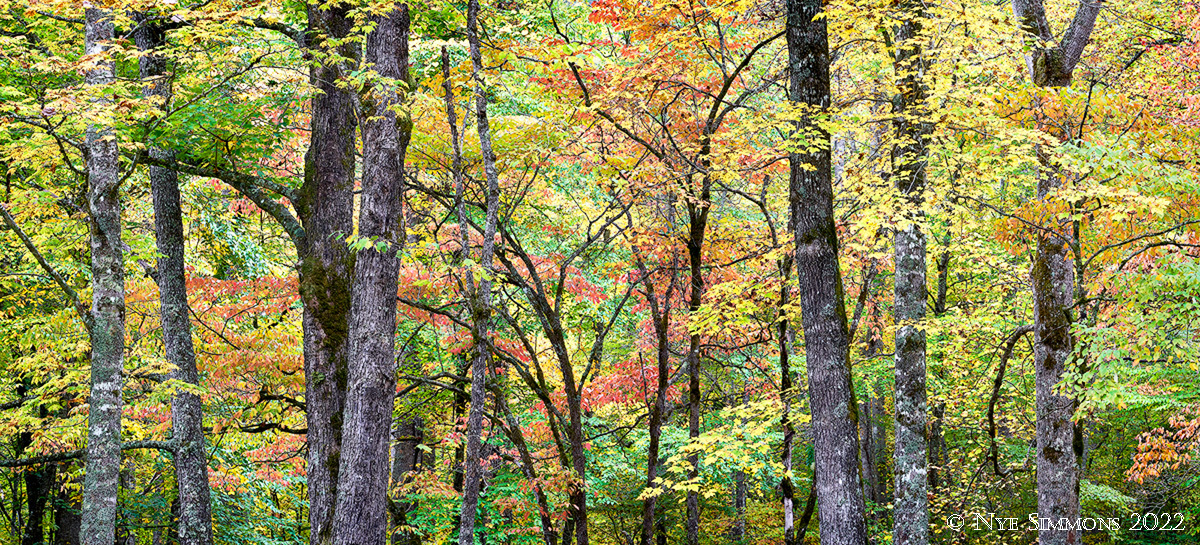
Well, folks, that time of year that photographers and non-photographers alike look forward to is nearly upon us: leaf season.
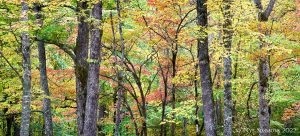
The park gets busy during this time of the year, but with or without a camera and stuck in traffic or not, the classic grand landscapes are still there to enjoy: sunrise at Foothills Parkway West, Oconaluftee Valley Overlook, and Deep Creek Overlook, as well as sunset at Clingmans Dome for a red sun setting over stacked ridges.
For more intimate and personal views, try the road less traveled; it’s a great way to beat the crowds. Wonderful excursions await in Tremont, Elkmont, Greenbrier, Big Creek, Cataloochee, and Deep Creek, to name a few. Cades Cove can be wonderful as well, but you must go early in the morning to avoid the bumper-to-bumper grind. If you are caught in it, consider taking Rich Mountain Road as an escape route back to Townsend. Little River Road offers multiple opportunities; just find a safe place to turnout and be mindful of traffic.
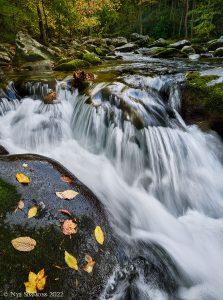
The color will start in the highest elevations around mid-October and continue through early to mid-November at the lowest elevations. Where to go depends on how much time you have and your expectations for the outing.
So, the camera thing. All that color—what to do? It can be overwhelming. Stop to look, enjoy the moment, and then look more closely. Break down the larger scene before you into its component parts, and you will find interesting compositions within the larger mass of color. Look for tree trunks or other forms to anchor the image and give it structure. When you look at a scene, see how the light falls on it. Look at lines, forms, and shapes and the relationships between them. Look for balance in similar or opposing colors and the interplay between light and shadow. Noticing and using these elements will take your photo to a higher level.
As color starts to develop, the woodlands become vibrant.
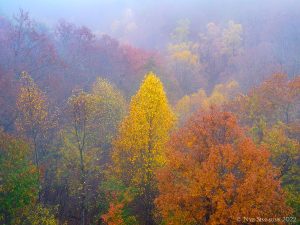
Look for dogwoods in picnic areas and other open places where the colors can show through. They are usually the first tree to show color and make a wonderful accent and focal point, as red immediately grabs attention in a photograph. Dogwood leaves tend to linger until the end of the season.
Streambeds are wonderful places to linger—with or without a camera. Several are roadside, making access easier. Moving water in its many forms is a beautiful thing, waiting for you to visit and enjoy some well-spent time. Soft light is desirable to even out the contrast. Overcast—even rainy—days are ideal, and early and late in the day, the canyons will be shadowed. A slow shutter speed (1/15 second or slower) will blur the water into silky smoothness; a faster one will freeze motion. Experiment with various shutter speeds for your desired effect. A tripod is helpful, but handheld is possible. Some phones have a long exposure option to render the silky effect; consult your manual.
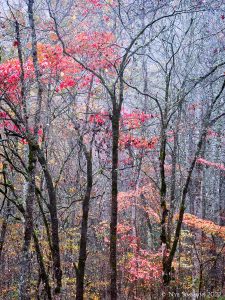
Full, peak color is glorious but needs some organization. Look for patterns of color, same or complimentary colors that balance each other, and general harmony when there aren’t more obvious forms to add structure. In this photo, there are two diagonals: one of yellow from mid-image towards upper right, the other red from lower right towards upper mid. While subtle, they help lead the eye through the scene.
When the leaves start to fall, the structure of the underlying trunks and branches starts to show through. This gives an almost infinite variety of artistic compositions after the postcard images have been taken. Only your imagination is required. Soft light is not the only condition to explore; great images can be made in backlit and side-lit conditions.
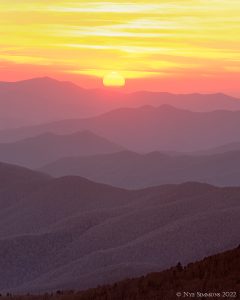
The classic view of the setting sun over stacked ridges occurs at Clingmans Dome in the fall. The sun swings almost 60 degrees by the compass throughout the year; earlier, in summer, it is best viewed from Ben Morton Overlook. It swings into view at Clingmans Dome sometime in September. If you go there for sunset, have snacks with you or a tailgate meal; traffic can be quite congested coming off the mountain, posing challenges for dinner reservations.
All this magnificent display can be enjoyed at many levels, from casual glance to deep inspection. As you learn to use your camera (or your phone) you will start to see things that you have previously missed. Your vision will become more focused, and you will start to see things that others miss, though you are standing side by side. The camera focuses your “looking” and helps it become “seeing.” Seeing involves appreciating the interplay of light, line, form, and color within the scene before you—the makings of a great photograph. Great photographs are made not taken, but first you must see it. So, go forth, enjoy, and make memories.
Subscribe to get the latest posts sent to your email.
The Great Smokies Welcome Center is located on U.S. 321 in Townsend, TN, 2 miles from the west entrance to Great Smoky Mountains National Park. Visitors can get information about things to see and do in and around the national park and shop from a wide selection of books, gifts, and other Smokies merchandise. Daily, weekly, and annual parking tags for the national park are also available.